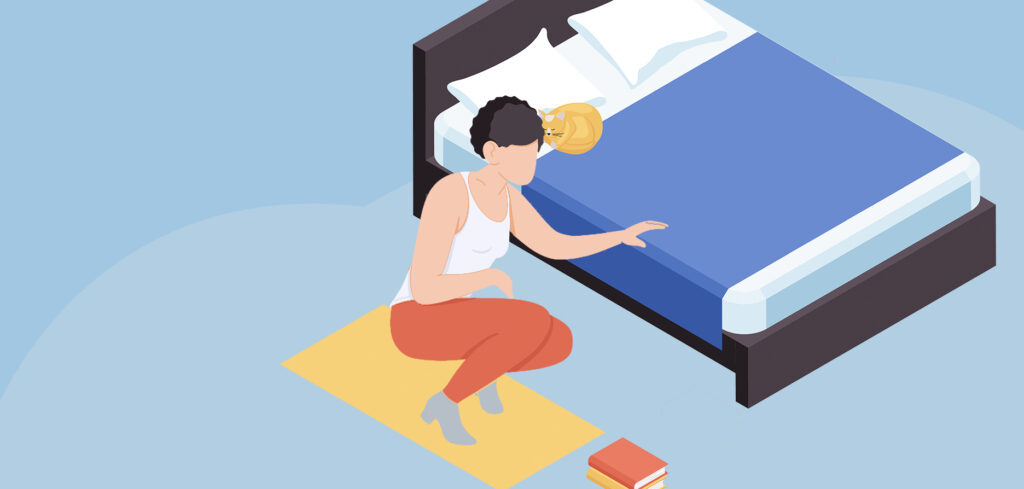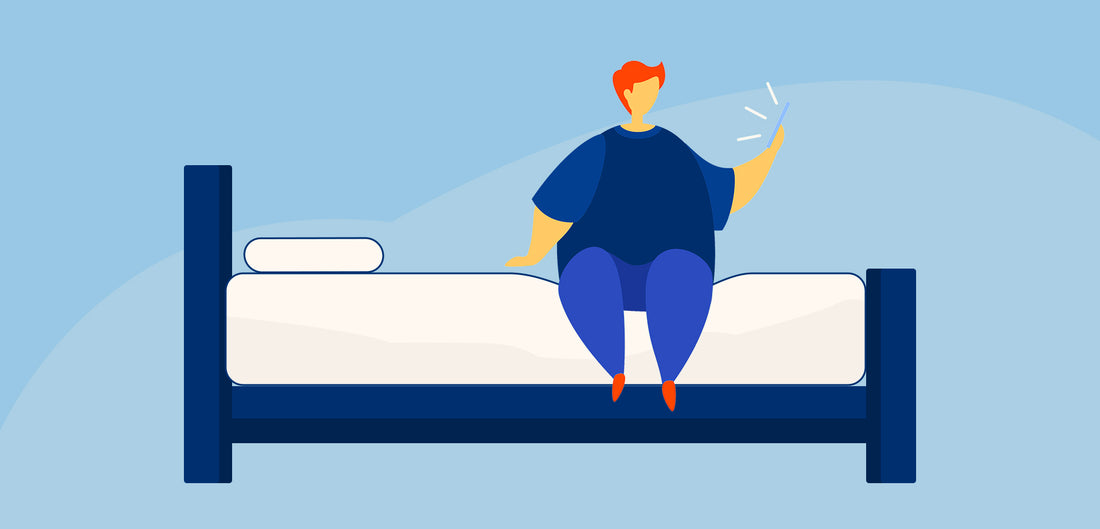If one is curious about what helps a mattress stay firm and stable, the concept of edge support may be worth considering. This is a crucial aspect of a mattress's design, comfort, and longevity.
In this article, we will delve into the details of edge support in mattresses, explaining why it is so essential and how it contributes to the overall quality of a mattress.
Why is Edge Support so Important?
When it comes to the lifespan and durability of a mattress, the edge plays a crucial role in its design. It helps prevent compression and sagging caused by body weight. Without proper edge support, this compression would become more noticeable much earlier.
When choosing a mattress, it's also crucial to consider the quality of its manufacturing, particularly the edges. If the mattress edges are not well-made, sleepers may experience an uneven sleeping surface right from the beginning. This causes financial frustration and can lead to discomfort in different parts of the body.
Good support around the mattress's edge helps maintain stability and avoid sleep disruption. If the edges are not reinforced, sleepers may feel like they are about to roll off the bed, leading to involuntary movements as the body tries to maintain balance, disrupting deep sleep cycles.
From a safety perspective, it's even more crucial that the mattress has proper edge support, especially given that older people or individuals with disabilities are on the edge to help them sit on the bed and get out of it safely. Weak edge support could increase the risk of falls and injuries when entering or exiting the mattress.
Beds with reinforced edges allow sleepers to use the entire top surface of the mattress comfortably. Shoppers must remember that each type of mattress has unique nuances regarding the edge, depending on the mattress's material.
Edge support and mattress material
Edge support is a crucial factor to consider while purchasing a mattress. However, it may only be necessary for some types of mattresses available in the market. The requirement for edge support varies based on the materials and construction of the mattress. Different mattress designs, such as latex, hybrid, and memory foam, have their unique approach to providing edge support.
Innerspring
Edge support is crucial for coil mattresses to uphold their shape. Manufacturers use steel rods, dense foam rails, or extra coils around the perimeter. Due to repeated body weight, these coils may sag and compress along the edges without additional reinforcement.
Memory foam
The memory foam design has a unique feature wherein additional edge support is not always required. This is because the foam mattresses have a substantial density from corner to corner. Moreover, memory foam molds to the shape of the body, which further eliminates the need for on-edge support. Its high responsiveness is another reason this type of mattress does not always require edge support.
Hybrids
With the combination of coils on the inside and the comforting layers of memory foam surrounding them, these mattresses typically incorporate edge support systems similar to innerspring models to prevent premature wear and reinforce the perimeter.
How to check a bed's edge support

While mattress companies have specialized equipment to measure edge support during design, consumers can also evaluate it themselves by doing some simple tests:
The sitting test
Position yourself on the edge of the mattress with your feet touching the floor in a natural sitting position.
- Observe the Support - Assess how the mattress responds to your weight. Good edge support should maintain its shape without excessive sagging.
- Test the Stability - While sitting on the edge of the mattress, shift your weight from one side to the other. You shouldn't feel excessive tilting or tipping.
- Check for Comfort - While sitting on the edge, the mattress should feel comfortable and supportive without causing discomfort on your pressure points.
- Repeat the Test - Make sure to repeat these steps along different areas along the edge of the mattress. This ensures the bed has consistent support across the entire perimeter.
Customers can use the sitting test to evaluate a mattress's edge support, stability, and comfort, helping them decide if it meets their needs.
Three-step test
The three-step test for edge support involves getting in and out of the bed while applying stress on the edge. By doing this, testers can evaluate the mattress's resilience. Testers should repeat this process multiple times to check for compression and any noticeable changes in the edge support. Additionally, the speed at which the bed regains its shape after exiting is another crucial factor. It's important to note that edge support tests usually take some time to show any real difference.
Edge laying test
To conduct this test, testers need to position themselves at the center of the mattress and then slowly move toward the edge. This test aims to show any instability as the body gets near the edge. Manufacturers also use this test to measure the degree of compression. If there is any physical discomfort while approaching the edge, it could be an indication of insufficient support around the bed's perimeter.
Who Needs Reinforced Mattress Edges?
Edge support is important for all sleepers, but it is particularly crucial for certain groups. These groups include:
- Plus-sized sleepers - Individuals over 250 pounds exert a significant downward force that can compromise unsupported edges over time.
- Those with mobility issues - Elderly sleepers and people with conditions like arthritis rely on sturdy edges for stability in and out of bed.
- Those recovering from injury - Added support aids people healing from back injuries, surgery, fractures, and other medical issues.
- Restless sleepers - People who toss, turn, and frequently change positions benefit from reinforced edges that provide consistent stability.
- Children and teens - Younger sleepers often utilize the full mattress surface, including the edges and corners, while playing or sleeping.
Edge support is a crucial feature for certain populations due to health, weight, age, and sleep habits, but it is also beneficial for all sleepers.
Mattress Edge Support You Can Rely On
Considering the importance of having proper edge support, here are some of MLILY's top picks for mattresses:
| Mattress | Description | Price |
| Mprove 2.0 | This all-foam mattress is infused with CBD and has a medium-firm feel, making it an excellent choice for most sleepers. | $1,499 - $3,499 |
| Harmony Chill 3.0 | A plush mattress with a quality foam construction that provides ample edge support without compromising the soft feel for a comfortable sleep. | $2,299 - $3,999 |
| Fusion Luxe | A popular medium-plush hybrid that offers a great blend of support and comfort. It also features a layer of Gel AeroFusion Memory Foam. One of MLILY's best-selling mattresses that offers a great blend of support and comfort. It also features a layer of Gel AeroFusion Memory Foam to promote airflow and a cooler sleep all night. Medium-plush hybrid that offers a great blend of support and comfort. It also features a layer of Gel AeroFusion Memory Foam. | $1,999 - $3,499 |
| ONYX Pro Hybrid Medium | Built using a combination of graphene cooling technology and two specialty foams, this bed is popular for those seeking maximum support throughout the night. | $1,599 - $2,999 |
Edge Support By Sleeping Position
An Individual's preferred sleeping position plays a significant role in determining the necessary support that the body needs from a mattress. Edge support is particularly crucial in catering to each position in the following ways:
- Back Sleepers: Reinforced edges maintain spinal alignment by preventing hips and shoulders from sinking, which helps to reduce back pain.
- Side Sleepers: Sturdy edges support pressure points such as hips and shoulders, minimizing numbness and discomfort.
- Stomach Sleepers: This sleeping position requires a firmer mattress and better edge support to help keep the hips from sinking in. Firm edges keep the hips elevated and the spine in proper alignment, preventing back strain as well.
- Combination Sleepers: Consistent edge stability supports continuous movement and various positions. Hybrid mattresses often work best.
Choosing a mattress that offers the right level of support for the body can be difficult. However, paying attention to the main pressure points and any areas of discomfort can help make a well-informed decision. Adequate edge construction provides customized support, preventing uneven sinking as positions shift at night.
Final thoughts
Edge support is an important factor when shopping for a mattress, although it is often overlooked. Durable edges prevent sagging, provide stability, and allow full use of the mattress surface, extending the mattress's lifespan. Consumers can easily evaluate edge support with the method provided in this article to choose a mattress with reinforced perimeters to ensure restful sleep. For those who need help figuring out where to start, check us out at MLILY. We offer a wide variety of mattresses to meet every individual needs, and we are confident that we can assist you in finding the perfect one!
